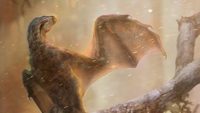By Ken Ham We constantly see headlines proclaiming the “rapid evolution” of one species or another. The latest one announced the so-called “rapid evolution” of bird species in the tropical island paradise of Hawaii. It’s happening so fast, they describe it as “a blistering pace” of evolution. But, like all the other supposed “rapid evolution” articles, there’s no evolution taking place—just changes based on the genetic diversity that likely already existed in the living thing. The popular article summarizing the research explains that non-native birds are replacing the now extinct species previously native to Hawaii. These birds have quickly filled [More]
A critic says creation isn’t science. How would you respond? …read more Source: creation.com
When were these geomorphological features carved? …read more Source: creation.com
Sneak peek of latest Creation magazine. Can fossils form quickly under the right conditions? …read more Source: creation.com
Rapidly carved by channelized Flood runoff …read more Source: creation.com
Hybridization occurs in the wild more than evolutionists thought. What does this mean for biblical creation? …read more Source: creation.com
By Ken Ham Due to their evolutionary assumptions, evolutionists believe so-called “early” animals are simple. One such animal is the tube anemone. Because they live slow, long, predictable lifestyles, it was assumed that they were simple. But new research shows their mitochondrial DNA is anything but simple. Mitochondrial DNA (mtDNA, located in the mitochondria of the cell and not the nucleus) is usually found in a ring shape, but in the tube anemone, it’s found in linear fragments. And the tube anemone now holds the record for the largest mitochondrial genome of any animal, with 81,000 base pairs. In comparison, [More]
By Troy Lacey The first Denisovan fossil outside Siberia has been found. What are Christians to think of this mysterious people group? …read more Source: AIG Daily
Using data obtained from the Hubble Space Telescope, astronomers have confirmed a contradiction between two different estimates of the Hubble constant—an extremely important number in cosmology.1 Secular scientists claim the universe is expanding as a result of a “Big Bang” 13-14 billion years ago. The inference of an expanding universe is based on the fact that the light spectra from dist… More… …read more Source: icr.org
By Ken Ham A new study, summarized in a lengthy National Geographic article, looked at the genome of over 200 fossil horses, as well as domesticated horses and the Przewalski’s horse, a rare wild horse in Mongolia. The National Geographic headline declared, “Speedy horses evolved only recently, says landmark equine study.” But what they were really looking at was not evolution—it was artificial selection! The study compared genetic diversity between fossil horses and living ones, including our domesticated varieties (of which there are around 600, all belonging to the same species). And what they found was that genetic diversity is [More]
By Frank Sherwin and Jeffrey Tomkins Fruit flies have been the foundational invertebrate of biology research for decades. Not only do they resist change, but there’s no record—fossil or otherwise—of their evolution from an unknown arthropod ancestor and they are clearly not related to any other creature.1-3 They have always been fruit flies. Researchers have recentl… More… …read more Source: icr.org
Sometimes scientists are so enthralled by the wonders of the nitty-gritty, they forget what’s really at issue. …read more Source: creation.com
Complex operations within a cell have to be present from the start for it to function at all. Read More
The past is the key to the present understanding of these geological features. …read more Source: creation.com
Fleeing the rising waters of Noah’s Flood …read more Source: creation.com
By Ken Ham Headlines around the world are announcing the discovery of a new species of “bat-wing dinosaur” uncovered in China. Researchers are dating this find at 163 million years old. They claim this new species, Ambopteryx longibrachium, had a membranous wing, similar to bats, and that it was a non-avian theropod (read: dinosaur) that represents a dead-end in the evolution of flight. But what was this creature? Be Careful When Reading Popular News Reports! Dr. Gabriela Haynes, a paleontologist who works with our research department, analyzed the scientific paper, published in the journal Nature. Dr. Haynes said when she [More]
By Dr. Elizabeth Mitchell Tiny technology—an environmentally matched biological cloaking device—hides shrimp in plain sight. …read more Source: AIG Daily
Taking the bite out of evolution. …read more Source: creation.com
A recent study on a plant in the mustard family (Brassica Rapa) provides evidence that plants continuously track environmental changes both in real time and across generations. Brassica Rapa utilize regulated innate mechanisms to produce “rapid” and highly tailored responses to the presence of pollinating bees, leaf-eating caterpillars, and the combined activities of both simultaneously.1 … More… …read more Source: icr.org
By Dr. Danny R. Faulkner The latest measure of the Hubble constant (H0) recently made headlines. …read more Source: AIG Daily
By Ken Ham The more we learn about what God has created, the more in awe of our Creator we should be. Just when we think we understand something, a new study shows we really didn’t know as much as we think we did. In fact, as finite beings we know hardly anything about creation compared to what there is to know. The layers of complexity in God’s creation are simply astounding! And that was highlighted in a new study that showed it’s not just our nose that contains olfactory receptors (the protein responsible for detecting smells)—it’s also our tongue. [More]
Does a “primitive” frog show how frog-hopping evolved? …read more Source: AIG Daily
Does lengthening the ‘time frame’ of the Cambrian explosion make it easier for evolutionists to explain? Read More
The word “scallop” usually evokes a juicy, round adductor muscle – a seafood delicacy. So it isn’t widely known that scallops have up to 200 tiny eyes along the edge of the mantle lining their shells. The complexities of these mollusk eyes are still being unveiled. A new study published in Current Biology reveals that scallop eyes have pupils that dilate and contract in response to light, making them far more dynamic than previously believed. “It’s just surprising how much we’re finding out about how complex and how functional these scallop eyes are,” says Todd Oakley, an evolutionary biologist [More]
By Ken Ham Researchers in the South American nation of Chile have announced the discovery of a human footprint they’ve dated at 15,600 years. This makes it the oldest evidence of humans in the Americas by over 3,000 years, according to the evolutionary timeline. How should Christians understand finds such as these? Well, first we compare what the study says against the absolute authority of the Word of God. Starting with God’s Word (using the six days of creation and the genealogies), we know the earth is only around 6,000 years old, and the world was destroyed at the time [More]
By Harry F. Sanders, III A study looked at the colors of lice on the feathers of numerous varieties of pigeons. According to the authors, the research was proof of evolution. Is it so? …read more Source: AIG Daily
How did their digestive biology change to make them need meat? …read more Source: creation.com











































